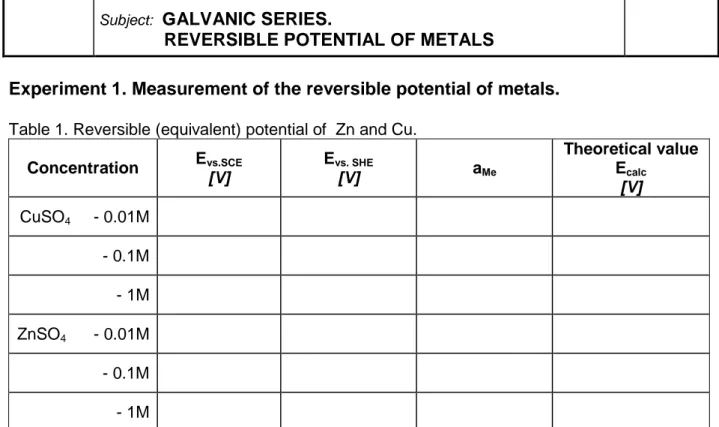GALVANIC SERIES. REVERSIBLE POTENTIAL OF METALS.
Experiment 1.
Measurement of the reversible potential of metals.
Laboratory Equipment: - calomel electrode - salt bridge - beakers - sandpaper - digital potentiometer - flex Chemicals: - Zn and Cu electrodes - CuSO4 solutions: 0.01M, 0.1M, 1M - ZnSO4 solutions: 0.01M, 0.1M, 1M - ethyl alcohol
Clean Zn and Cu electrodes with sandpaper, wash with distilled water and alcohol. Immerse the Cu electrode in 0.01M CuSO4 solution, connect it to the reference electrode with salt
bridge. Then connect both electrodes to potentiometer. After switching on the potentiometer, wait until the potential reaches stable value (about 3 minutes), than note down the potential. Repeat the same procedure for each concentration, beginning from the lowest one. Follow the corresponding measurements for the zinc electrode.
Caution: Pour back he solution into the same bottle after the measurements. Experiment 2.
Measurements of the electromotive force of Daniell's cell.
Laboratory Equipment: - salt bridge - beakers - sandpaper - digital potentiometer - flex Chemicals: - Zn and Cu electrodes - CuSO4 solutions: ,0.1M, 1M - ZnSO4 solutions: 0.1M, 1M - ethyl alcohol
Build Zn ZnSO4 ║CuSO4 Cu cell with concentration of 0.1M of both solutions.
The electrodes should be previously cleaned as in experiment 1. Measure the value of the electromotive force of cell with use of digital potentiometer. Build another Daniell’s cell, using the solutions with concentration of 1M and measure electromotive force of this cell.
Caution: Pour back he solution into the same bottle after the measurements. Experiment 3.
The concentration cell. Measurement of electromotive force of cell
Laboratory Equipment: - salt bridge - beakers - sandpaper - digital potentiometer - flex Chemicals: - 2 Cu electrodes - CuSO4 solutions: 0.01M, 0.1M, 1M - ethyl alcohol
Build the cells: Cu 0.01M CuSO4║1M Cu SO4 Cu
Cu 0.1M CuSO4║1M Cu SO4 Cu
Put potentiometer into outer circuit of the cell and after the electromotive force reaches the stable value (after about 3 minutes) note it down.
20..../…. Gr.
Name, surname:
Subject:
GALVANIC SERIES.
REVERSIBLE POTENTIAL OF METALS
Assistant signature
Experiment 1. Measurement of the reversible potential of metals.
Table 1. Reversible (equivalent) potential of Zn and Cu.
Concentration Evs.SCE [V] Evs. SHE [V] aMe Theoretical value Ecalc [V] CuSO4 - 0.01M - 0.1M - 1M ZnSO4 - 0.01M - 0.1M - 1M
Calculate, basing on Nernst’s equation, the theoretical potential value for the zinc and copper in the examined solutions.
Use the equation to calculate:
n + n + o Me Me Me n loga 059 , 0 E = E
Activity of the metal (a) in dependence of solution concentration (c) is given by the relation
a = f·c
The activity coefficient (f) for the examined concentrations is given in table 2
Calculate the potential of metal in relation to the hydrogen electrode basing on the formula: E
SHE = ESCE + Evs.SCE, where: ESCE = +0.244 V
Evs.SCE - measured value of metals potential versus ESCE.
Table 2. Activity coefficients (f) for different concentrations of the electrolyte.
Electrolyte Solutions concentration
0,01 0,1 1,0
CuSO4 0,400 0,150 0,047
ZnSO4 0,387 0,150 0,044
Compare the theoretical values with the data received in the experiment.
Experiment 2.
Measurements of the electromotive force of Daniell's cell.
Compare the values of the electromotive force measured for Daniell’s cell with the electrolyte concentration of 0.1M and 1M, with the theoretically calculated values basing on the Nernst’s equation.
SEMcalc = Ecathode - Eanode
Cell SEM measured
[V] SEM calculated [V] Zn 0,1M ZnSO4 0,1M CuSO4 Cu Zn 1M ZnSO4 1M CuSO4 Cu Conclusions: Experiment 3.
Measurements of the electromotive force of concentration cell.
Compare values of the electromotive force measured for cell 1 and 2 with theoretically calculated differences of the potential for the copper electrode in the example 1 . What should be the theoretical difference of the potential of electrode for the reaction Cu - 2e Cu2+ with the change of the electrolyte concentration by one and two orders of magnitude.
Cell SEM measured
[V] SEM calculated [V] Cu 0,01M CuSO4 1M CuSO4 Cu Cu 0,1M CuSO4 1M CuSO4 Cu Conclusions:
